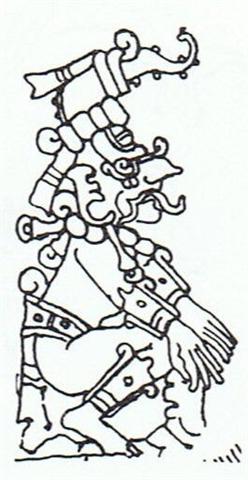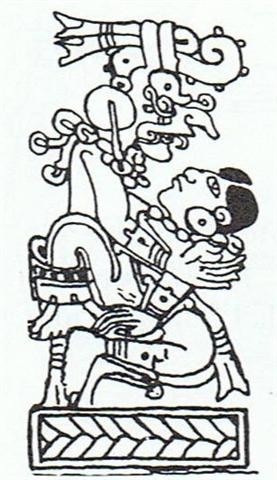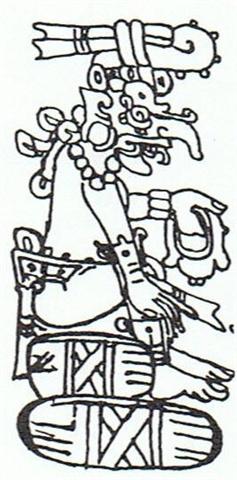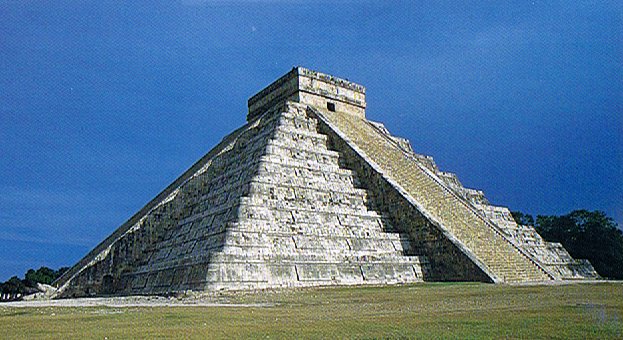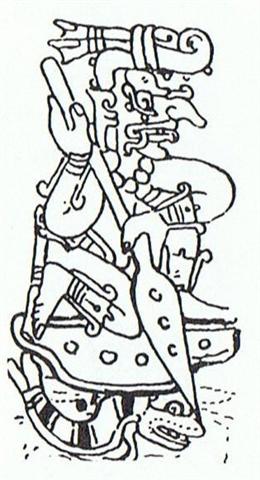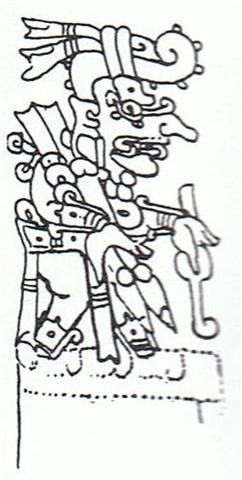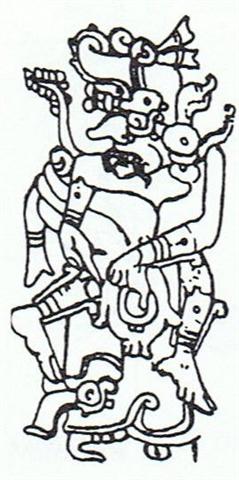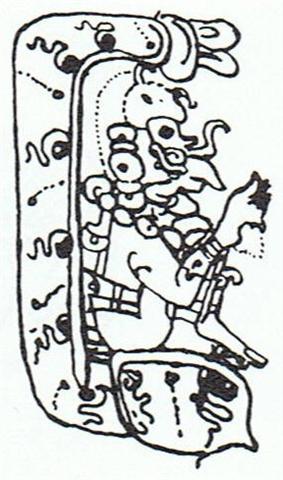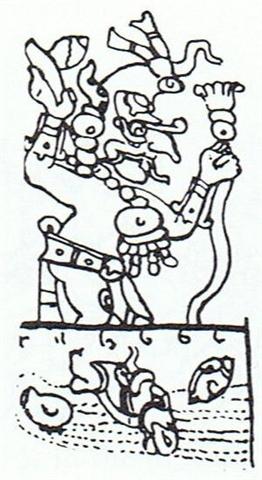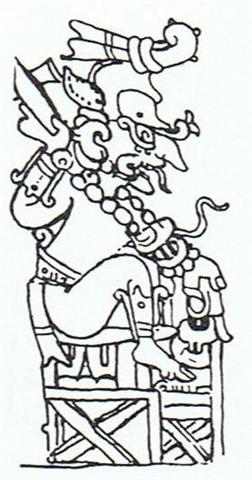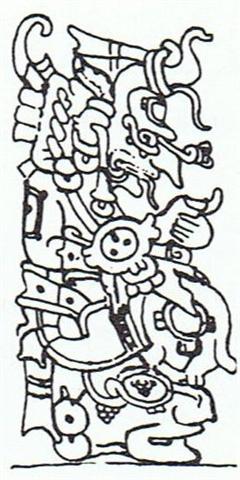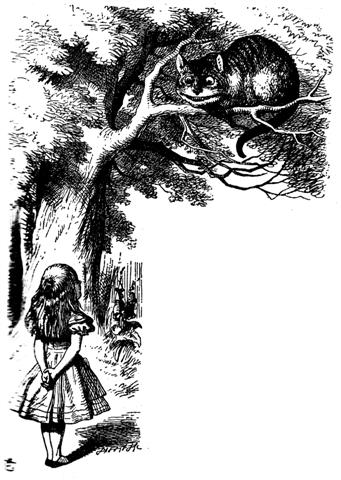|
584
31 When you are reborn you cannot remember anything from your previous life. Here is the begiinning of the new growth of a life of learning:
Which will be followed by pairing up at maturity:
And these 2 panels (quarters) will then be followed by another pair representing the 3rd and 4th quarters in this initiating overview:
The 'earth' had 4 quarters, as in the 'Nunnery':
... An iconographic study by Jeff Kowalski suggests a cosmological layout for the Nunnery. The higher placement of the North Building, with its 13 exterior doorways (reflecting the 13 layers of heaven), and the celestial serpents surmounting the huts identify it with the celestial sphere. The iconography of the West Building, with 7 exterior doorways (7 is the mystic number of the earth's surface), and figures of Pawahtun - the earth god as a turtle - indicate this to be the Middleworld, the place of the sun's descent into the Underworld. The East Building has mosaic elements reflecting the old war cult of Teotihuacan, where tradition had it that the sun was born; thus, this may also be Middleworld, the place of the rising sun. Finally, the South Building has 9 exterior doorways (the Underworld or Xibalba had 9 layers), and has the lowest placement in the compex; it thus seems to be associated with death and the nether regions ... Then we can follow how 13 - 4 = 9 panels (months) seem to be used in order to describe another part of the time-space cosmos, viz. that which is beginning high up with a canoe journey:
Which is followed by a fall through the air in order to reach the muddy virgin ground:
... In the morning of the world, there was nothing but water. The Loon was calling, and the old man who at that time bore the Raven's name, Nangkilstlas, asked her why. 'The gods are homeless', the Loon replied. 'I'll see to it', said the old man, without moving from the fire in his house on the floor of the sea. Then as the old man continued to lie by his fire, the Raven flew over the sea. The clouds broke. He flew upward, drove his beak into the sky and scrambled over the rim to the upper world. There he discovered a town, and in one of the houses a woman had just given birth. The Raven stole the skin and form of the newborn child. Then he began to cry for solid food, but he was offered only mother's milk. That night, he passed through the town stealing an eye from each inhabitant. Back in his foster parents' house, he roasted the eyes in the coals and ate them, laughing. Then he returned to his cradle, full and warm. He had not seen the old woman watching him from the corner - the one who never slept and who never moved because she was stone from the waist down. Next morning, amid the wailing that engulfed the town, she told what she had seen. The one-eyed people of the sky dressed in their dancing clothes, paddled the child out to mid-heaven in their canoe and pitched him over the side ... 4 + 3 = 7 (→ the mystic number of the earth's surface). ... Far away, the Mangaians of old (Austral Islands, Polynesia), who kept the precessional clock running instead of switching over to 'signs', claim that only at the evening of the solstitial days can spirits enter heaven, the inhabitants of the northern parts of the island at one solstice, the dwellers in the south at the other ... Considering the fact that the crossroads of ecliptic and Galaxy are crisis-resistant, that is, not concerned with the Precession, the reader may want to know why the Mangaians thought they could go to heaven only on the two solstitial days. Because, in order to 'change trains' comfortably, the constellations that serve as 'gates' to the Milky Way must 'stand' upon the 'earth', meaning that they must rise heliacally either at the equinoxes or at the solstices. The Galaxy is a very broad highway, but even so there must have been some bitter millenia when neither gate was directly available any longer, the one hanging in midair, the other having turned into a submarine entrance Then follows a junction between the Rain God (King) and the Tree, where he will be looking back - for he cannot go any fuirther ahead:
... Most of the people in our van took advantage of the interlude to shop at the nearby stalls set up by highland Maya who had come down to Tikal to take advantage of the steady supply of tourists. However, one of our group, Harriet Gillett, a retired physician and an inveterate bird-watcher, had other interests. She noticed a nearby tree hevy with white blossoms and surrounded by a raucous sphere of birds and bees. She climbed out of the van with her binoculars around her neck, and walked over to take advantage of the unexpected opportunity the morning had provided. Our local guide, Francisco Florián, who knew the forest and its creatures in an unusually intimate way, joined her, explaining that the birds came to the tree only early in the morning. The sounds and the odd sight finally drew my attention and I too disembarked from the van and edged closer to the buzzing center of the action. I stared at the screaming birds as they fought for positions among the flowers and the hovering drone of thousands of bees. How beautiful, I thought, and then my gaze happened to settle on the trunk of the tree. It had thorns and it bulged just above the ground. It was a young ceiba tree. I already knew that the ceiba tree was the model for the sacred World Tree of the Maya, but I had never seen one in flower when I knew what I was looking at. I was really excited because normally you can't see the blossoms even if you're there when the tree is in blossom. The fully mature trees are hundreds of feet high. and the blossoms are very small. 'It's a ceiba', I chirped and began looking for a branch low enough to see one of the blossoms up close. Joyce Livingstone, a retired teacher, did the logical thing. She bent over, picked up a fallen branch, and held it out for me to see. I was too excited and full of myself to listen. She tapped my arm more insistently and still I didn't hear her. Finally, in frustration, she grabbed my wrist and raised her voice. 'Will you look at these?' she said, waving the branch, and finally I did. What I saw stunned me, for in her hand lay a perfect replica of the earflares worn by the Classic Maya kings. Suddenly I understood the full symbolism of so many of the things I had been studying for years. The kings dressed themselves as the Wakah-Chan tree, although at the time I didn't know it was also the Milky Way. The tzuk [partition] head on the trunk of the tree covered their loins. The branches with their white flowers bent down along their thighs, the double-headed ecliptic snake rested in their arms, and the great bird Itzam-Yeh stood on their head. I already knew as I stood under the young tree in Tikal that the kings were the human embodiment of the ceiba as the central axis of the world. As I stood there gazing at the flowers in Joyce's hand, I also learned that the kings embodied the ceiba at the moment it flowers to yield the sak-nik-nal, the 'white flowers', that are the souls of human beings. As the trees flowers to reproduce itself, so the kings flowered to reproduce the world ... And after midsummer his true self will no longer be visible:
... Atea then became the wife of Rua-tupua-nui, Source of Great Growth, and they became the parents of all the celestial beings, first the shooting stars, then the Moon and the Sun, next the comets, then the multitude of stars and constellations, and finally the bright and dark nebulae. When this tremendous task had been accomplished Atea took a third husband, Fa'a-hotu, Make Fruitful. Then occurred a curious event. Whether Atea had wearied of bringing forth offspring we are not told, but certain it is that Atea and her husband Fa'a-hotu exchanged sexes. Then the eyes of Atea glanced down at those of his wife Hotu and they begat Ru. It was this Ru who explored the whole earth and divided it into north, south, east, and west ... 7 (earth's surface, the 'turtle') + 3 (underground, sea, night).= 10. Number 11 (one more) will then correspond to the other junction (yoke) between the Rain God (Hunaphu) and the Tree, this time allowing him to look 'a-head':
Because by way of his 'bone' (skeleton) he could now begin to return:
... And then the bone spoke; it was there in the fork of the tree: Why do you want a mere bone, a round thing in the branches of a tree? said the head of One Hunaphu when it spoke to the maiden. You don't want it, she was told. I do want it, said the maiden. Very well. Stretch out your right hand here, so I can see it, said the bone. Yes, said the maiden. She stretched out her right hand, up there in front of the bone. And then the bone spit out its saliva, which landed squarely in the hand of the maiden. And then she looked in her hand, she inspected it right away, but the bone's saliva wasn't in her hand. It is just a sign I have given you, my saliva, my spittle. This, my head, has nothing on it - just bone, nothing of meat. It's just the same with the head of a great lord: it's just the flesh that makes his face look good. And when he dies, people get frightened by his bones. After that, his son is like his saliva, his spittle, in his being, whether it be the son of a lord or the son of a craftsman, an orator. The father does not disappear, but goes on being fulfilled. Neither dimmed nor destroyed is the face of a lord, a warrior, craftsman, an orator. Rather, he will leave his daughters and sons. So it is that I have done likewise through you. Now go up there on the face of the earth; you will not die. Keep the word. So be it, said the head of One and Seven Hunaphu - they were of one mind when they did it ...
|
||||||||||||||
